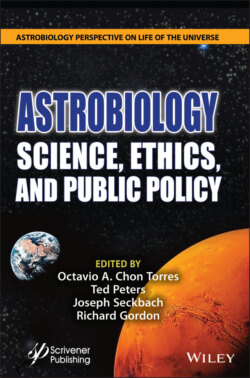Читать книгу Astrobiology - Группа авторов - Страница 22
2.1 Introduction
ОглавлениеAstrobiologists along with astronomers and astrophysicists are ready to take the next step in refining astroethics, ethics for space exploration. Might we consider thinking of space beyond Earth as a commons, a domain to be shared by both earthlings and space neighbors? Might we lift up a vision of the common good that includes yet transcends our home planet?
Apollo 11 astronaut, Buzz Aldrin, says the time has come in which “Space offers us, or rather has allowed us to adopt for ourselves, a new dimension of freedom, which we must use for the benefit of humanity, to enrich and not degrade our lives” [2.1]. The time has come because space explorers need policies, policies that are ethically informed and formed. SETI astrobiologist Margaret Race identifies this need to add ethics to our science. “There are no specific policies or statements regarding ethical considerations or the broader impacts of human activities, particularly in relation to ET life and environments. Moreover, there is no guiding framework for considering any non-scientific issues” [2.69]. The need for foundational ethical—especially astrobioethical—deliberation has arisen [2.13].
In this chapter we will entertain a series of quandaries in “astroethics,” sometimes called space ethics. We will divide the universe into two concentric spheres of moral concern, our solar neighborhood and the Milky Way metropolis. Because of the untraversable distances between galaxies, and because we have virtually no hope of ever devising a technology by which we could communicate faster than the speed of light, the largest sphere of moral concern we can seriously consider is the Milky Way. We will rely on the term “astroethics” to encompass the full scope of space ethics; the term “astrobioethics” will be employed when dealing specifically with off-Earth life forms.1
In addition to applying the common good to the Milky Way galaxy, this astroethical investigation will require identifying the moral agent. Here I nominate for the role of moral agent: Earth as a single planetary society. However, this raises a problem. Designating all the peoples of Earth functioning together as a moral agent is problematic because a single planetary society does not currently exist. Our planet Earth is governed formally by independent nations or, more materially, by competing economic and social interest groups. The very formation of a planetary society to deal with off-Earth matters is itself an ethical ideal and goal to pursue. As we pursue this vision of a cooperative human race, we must overcome the presumption of national sovereignty and the individuated interests competing in the economic sector.2 In addition. this vision of a single planetary community of moral deliberation must draw into the center of participation those who today are marginalized due to poverty, race, or gender. Astroethics is first of all earthling ethics, and then it becomes galactic ethics [2.59].
In what follows we will lay the foundation and begin the superstructure for a refined astroethics to aid in formulating public policy. In laying the foundation we will pose three quandary questions: Who are we? What do we value? What should we do? The cumulative answers to these three questions will lead to a foundation we will label “Astroethics of Responsibility” [2.63].
Atop this foundation we will frame a superstructure of quandaries regarding specific astroethical issues. The load-bearing vertical supports will include: (1) the moral agent: Earth; (2) the moral norm: the galactic common good; (3) the moral spheres: the solar neighborhood and the Milky Way metropolis; (4) the moral justification: a theological apprehension of the common good combined with a naturalistic apprehension of the Golden Rule.
The floor plan will designate a conference room for each of thirteen previously formulated ethical quandaries. Ten of these quandaries lie within the sphere of the solar neighborhood: (1) planetary protection; (2) intrinsic value of off-Earth biospheres; (3) application of the Precautionary Principle; (4) space debris; (5) satellite surveillance; (6) weaponization of space; (7) scientific versus commercial space exploration; (8) terraforming Mars; (9) establishing human settlements on Mars; and (10) anticipating natural space threats [2.63]. Three quandaries lie within the sphere of the Milky Way metropolis: engagement with intelligent extraterrestrials who are (1) less intelligent than Earth’s Homo sapiens; (2) ETI equal in intelligence; and (3) ETI superior in intelligence in both biological and postbiological forms [2.58].
